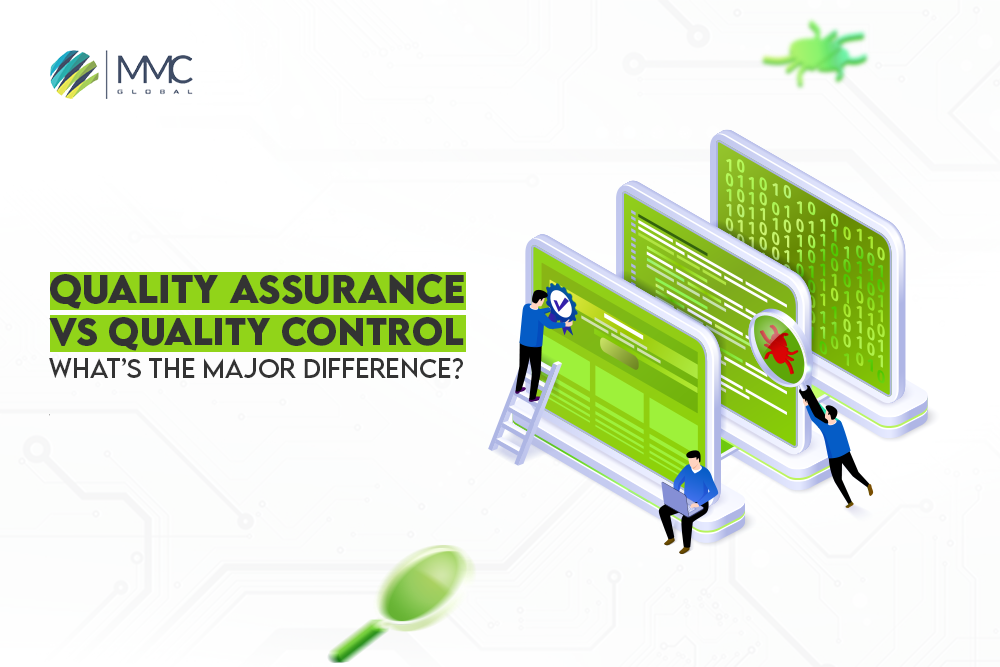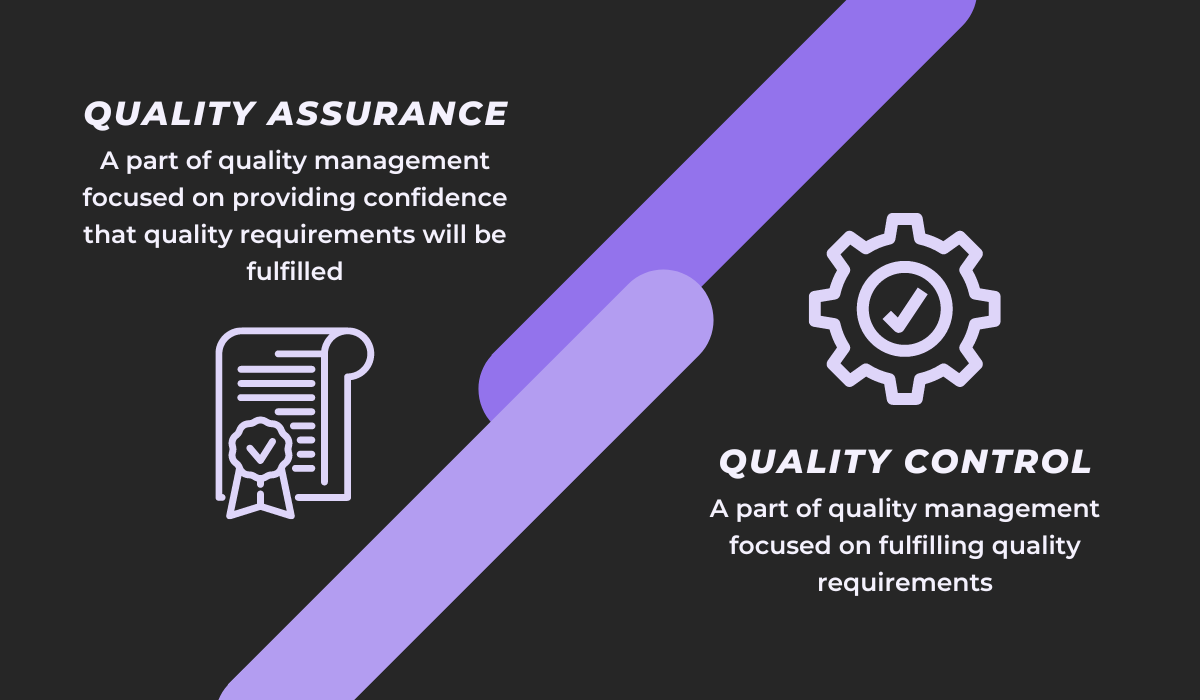Quality Assurance vs Quality Control – What’s The Primary Difference?


Quality Assurance vs Quality Control – first and foremost, they are not the same or can not be used interchangeably. They are very close to each other but possess a greater difference that sets them apart.
Quality assurance and Quality control are both critical aspects in manufacturing companies. Every single piece of product is thoroughly checked to maintain the product quality. Similarly, Quality assurance and Quality control are also important in application software development. During software development, the QA team creates multiple test cases and conducts different types of testing to ensure the software quality.
It is considered one of the vital steps in the software development cycle. Many application fails due to the lack of performance and irresposivness against any action. That is why continuous QA and QC must required to deliver exceptional experience.
Quality is a vital aspect of any product or service. Whether you’re manufacturing a physical product or providing a service, ensuring that it meets or exceeds the expected quality standards is crucial for success. In this pursuit of quality, two key concepts often come into play: Quality Assurance (QA) and Quality Control (QC). While they might sound similar, they serve distinct purposes in the larger context of quality management. In this comprehensive blog post, we will explore the primary differences between Quality Assurance and Quality Control as well as how they contribute to overall quality management.

What Is Quality Assurance (QA)?
Quality Assurance, often abbreviated as QA, is a proactive and process-oriented approach to quality management. Its primary objective is to prevent defects or issues from occurring in the first place rather than detecting and rectifying them after the fact. QA is a comprehensive system of policies, procedures, and processes to ensure that a product or service consistently meets or exceeds predefined quality standards. Let’s delve deeper into the key aspects of Quality Assurance:
1. Focus on Prevention
Quality Assurance is all about preventing quality issues before they can occur. It involves creating a framework as well as processes that minimize the likelihood of defects, errors, or issues at every stage of the product or service lifecycle. This proactive approach reduces the need for costly corrections down the line.
2. Process-Centric
QA emphasizes the development and implementation of standardized processes. These processes are documented and followed diligently to ensure consistency in product or service delivery. Regular audits and evaluations are conducted to ensure that these processes are being adhered to.
3. Continuous Improvement
A fundamental principle of QA is continuous improvement. Through data, feedback, and analysis, QA strives to identify areas where processes can be refined or enhanced. This iterative approach helps maintain and improve product or service quality over time.
4. Customer-Centric
QA is customer-focused, with the aim of meeting or exceeding customer expectations. It involves understanding customer requirements and ensuring that the design, development, and delivery of products or services in a manner that aligns with these expectations.
5. Long-term Perspective
Quality Assurance takes a long-term perspective, seeking to establish a quality culture within an organization. It involves training and developing personnel, implementing best practices, and fostering a commitment to quality at all levels of the organization.
What is Quality Control (QC)?
Quality Control, often abbreviated as QC, is a reactive and product-oriented approach to quality management. Its primary objective is identifying and rectifying defects or issues in the final product or service. QC involves the systematic examination and testing of the product or service to determine whether it meets the established quality standards. Here are the key aspects of Quality Control:
1. Focus on Detection
Quality Control focuses on detecting and addressing defects or issues after they have occurred. It involves inspecting and testing the product or service to identify deviations from the quality standards.
2. Product-Centric
QC is primarily concerned with the end product or service. It assesses the final output and takes measures to correct any deviations from the quality standards before it reaches the customer.
3. Inspection and Testing
QC involves various inspection and testing processes, which can be manual or automated. These processes are critical for identifying defects and ensuring the product or service complies with the quality criteria.
4. Immediate Action
When identifying quality issues through QC, immediate corrective actions are taken to rectify the problems. This may involve rework, repairs, or other necessary measures to bring the product or service back to compliance with quality standards.
5. Short-term Perspective
Quality Control focuses on short-term goals and immediate problem-solving. It does not address the root causes of issues but aims to ensure that the current product or service is of acceptable quality.
[Nasir-hu-mein heading=”Inspect Your Software Quality By QA Experts” para=”Do you have doubts about your software quality? Let us help you make your software bug-free and errorless to ensure your app performance.”]Primary Differences between QA and QC
Now that we’ve discussed the fundamental aspects of Quality Assurance and Quality Control let’s summarize the primary differences between these two approaches:
Prevention vs. Detection: The key distinction is that QA is focused on preventing quality issues, while QC is focused on detecting and addressing them after they occur.
Process vs. Product Orientation: QA centers on developing and following processes, while QC focuses on the end product or service.
Long-term vs. Short-term Perspective: QA adopts a long-term perspective. It emphasizes continuous improvement, while QC is more short-term and aims at immediate problem-solving.
Proactive vs. Reactive: QA is proactive, aiming to establish a quality culture and prevent defects. Whereas QC is reactive, dealing with defects as they arise.
Customer vs. End Product: QA is customer-centric, aligning with customer expectations. On the other hand, QC concentrates on inspecting and testing the final product or service.
The Synergy of QA and QC
It’s important to note that QA and QC are not mutually exclusive, and they often complement each other. An effective quality management system includes both QA and QC components. QA sets the foundation by establishing processes and a quality culture that minimizes the likelihood of defects. QC comes into play to validate the product or service’s quality through inspections and testing.
Read more: Software Quality Assurance & Testing – Process, Techniques, And Types
In practice, QA and QC work together to ensure that an organization consistently delivers high-quality products or services to its customers. The synergy of these two approaches creates a robust quality management system.
Conclusion
In summary, Quality Assurance and Quality Control are two distinct approaches to managing and ensuring the quality of products and services. Quality Assurance focuses on prevention, process orientation, continuous improvement, and a long-term perspective, while Quality Control is about detection, product orientation, short-term problem-solving, and immediate action.
However, to achieve the highest level of quality, organizations should embrace both Quality Assurance and Quality Control, recognizing that they are complementary components of a comprehensive quality management system.



